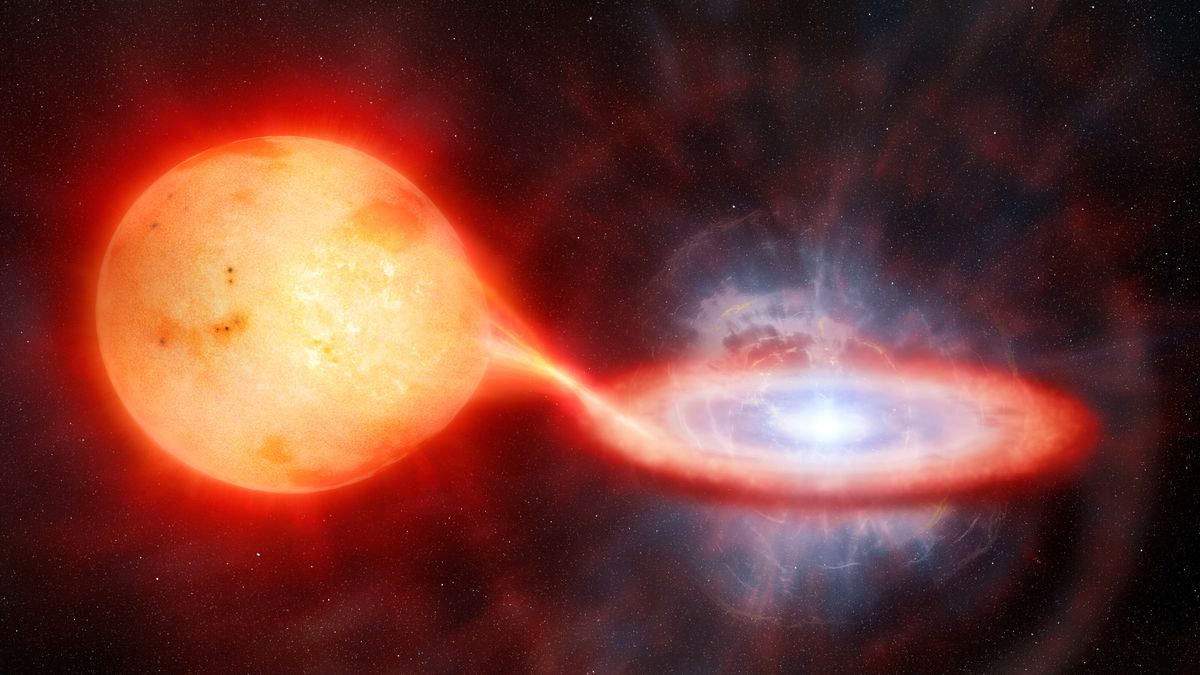Hold Onto Your Hats! Is the 'Blaze Star' T Corona Borealis About to Explode?
Introduction: A Cosmic Spectacle in the Making
Astronomers and stargazers are buzzing with excitement as T Corona Borealis (T CrB), a binary star system affectionately dubbed the "Blaze Star," shows signs of an impending nova explosion. This rare celestial event, which occurs roughly every 80 years, could soon light up the night sky in a dazzling display visible to the naked eye. But what exactly triggers this cosmic fireworks show, and when can we expect it?

Caption: An artist's depiction of T Corona Borealis, a binary star system where a white dwarf siphons material from its companion, setting the stage for a potential nova explosion.
The Science Behind the Blaze Star
A Vampiric Dance of Stars
T Corona Borealis is a recurrent nova, meaning it experiences periodic eruptions due to a unique stellar relationship. The system consists of: - A white dwarf—a dense stellar remnant with a gravitational pull so strong it steals matter from its companion. - A red giant—a larger, cooler star that serves as the white dwarf’s "donor." When the white dwarf accumulates enough hydrogen from the red giant, the stolen gas becomes superheated, triggering a runaway thermonuclear explosion—a nova. Unlike a supernova, which destroys the star, a nova leaves the system intact, allowing the cycle to repeat.
Historical Eruptions: A Predictable Pattern
T CrB has erupted twice in recorded history: - 1866: A sudden brightening made it one of the brightest stars in the night sky. - 1946: Another eruption followed the same 80-year pattern. Given this timeline, astronomers predict the next explosion could occur anytime between now and September 2024.
Why This Nova Matters
A Rare Opportunity for Study
Most novae are unpredictable, but T CrB’s regularity makes it a prime candidate for research. Scientists hope to: - Study the mechanics of mass transfer between stars. - Improve models predicting similar events. - Understand how novae contribute to galactic chemical enrichment.
A Stargazer’s Delight
When T CrB erupts, it will temporarily shine as brightly as Polaris (the North Star), making it visible without telescopes. Observers in the Northern Hemisphere should look toward the constellation Corona Borealis, a small semicircle of stars near Hercules.
How to Prepare for the Event
When and Where to Look
- Timing: The explosion could happen imminently—or take months. Astronomers monitor the system for precursor activity, such as changes in brightness. - Location: Find Corona Borealis by locating the bright star Arcturus and tracing upward to a distinctive "crown" of stars.
Capturing the Moment
For astrophotographers, this is a golden opportunity. A DSLR camera with a wide-field lens and a sturdy tripod can capture the nova’s glow. Even smartphone cameras may pick it up under dark skies.
The Bigger Picture: Novae in the Universe
Cosmic Recyclers
Novae like T CrB play a crucial role in distributing heavy elements into space. The explosions eject material like carbon, nitrogen, and oxygen, which eventually form new stars and planets.
A Reminder of Stellar Lifecycles
This event underscores the dynamic nature of stars. While our Sun will never go nova (it lacks a binary partner), witnessing T CrB’s eruption reminds us of the universe’s ever-changing nature.
Conclusion: A Celestial Countdown
T Corona Borealis is on the brink of a spectacular eruption—one that could illuminate the night sky any day now. Whether you're an astronomer, a casual stargazer, or simply someone who marvels at the cosmos, this is a rare chance to witness a stellar rebirth. Keep your eyes on Corona Borealis, and hold onto your hats—the Blaze Star is about to put on a show! --- Final Note: For real-time updates, follow NASA and major astronomy organizations, which will likely announce the eruption as soon as it happens.